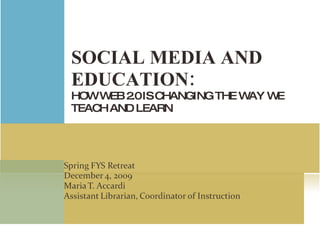FYS Spring Retreat
- 1. SOCIAL MEDIA AND EDUCATION: HOW WEB 2.0 IS CHANGING THE WAY WE TEACH AND LEARN
- 2. WHAT IS SOCIAL MEDIA ? Web-based communication tools that connect people based on interests and relationships Related terms: social computing, social software, online social tools, virtual communities, online social networking Examples: Facebook , Twitter , Social Bookmarking , Wikipedia
- 3. WHAT IS WEB 2.0? Characteristics include: Tim O'Reilly definition User-centered services delivered in a web-based platform Users have the ability to co-create goods and services rather than consuming end product Collaborative, self-organizing, self-policing communities that destabilize hierarchy and empower ordinary users Web 2.0 tools include: file sharing (photo/video/documents), tagging (user-created metadata), wikis (collaborative knowledge management), blogs (online interactive journals) , RSS feeds (syndication of frequently updated content), podcasting (downloadable digital audio media files)
- 4. COMMUNICATION AND SOCIAL MEDIA How have these social tools changed the way we communicate? Accessibility: anywhere there is an internet connection, you can communicate, and you can make yourself available to be communicated with Immediacy: connection is in real-time Multiple methods of interactivity: messaging (public and private), chatting, blogging, photo/video sharing
- 5. WHO IS USING THESE ONLINE TOOLS, AND WHY? A survey conducted by the Pew Internet and American Life Project reports: "More than half (55%) of all online American youths ages 12-17 use online social networking sites." "Older teens, particularly girls, are more likely to use these sites. For girls, social networking sites are primarily places to reinforce pre-existing friendships; for boys, the networks also provide opportunities for flirting and making new friends."
- 6. WHO IS USING THESE ONLINE TOOLS, AND WHY?
- 7. YOUTUBE YouTube is a video-sharing service that lets users upload files to YouTube servers, where they are available online. Implications for teaching and learning: Exposing students to visual literacy skills Engaging students as creators and commentators Experimenting with new media Source: 7 Things You Should Know About YouTube, EDUCAUSE
- 8. MICROBLOGGING Microblogging is the practice of posting small pieces of digital content—text, pictures, links, short videos—on the Internet. Twitter.com is the most well-known microblogging tool. Implications for teaching and learning: Offers a backchannel forum during live classes Send reminders of test dates and other deadlines Builds online community Announcements and notifications Source: 7 Things You Should Know About Microblogging, EDUCAUSE
- 9. GOOGLE APPS Google Apps are web-based programs and file storage tools with collaborative features built-in. They include communication tools ( Gmail , Google Calendar ) and productivity tools ( Google Docs —word processing, spreadsheets, presentation software) Implications for teaching and learning: Google tools are collaborative and enable easy sharing of information and content Easy way to publish student work Source: 7 Things You Should Know About Google Apps, EDUCAUSE
- 10. WIKIPEDIA Wikipedia is a free online Web-based encyclopedia that any one can add to or edit. It is one of the most popular online sources, and the article topics range from the very broad to the highly specific. Implications for teaching and learning: Students can be responsible for knowledge generation and part of a collaborative community of learners Development of research and information literacy skills Source: 7 Things You Should Know About Google Apps, EDUCAUSE
- 11. FACEBOOK Wikipedia is an online social networking site where user interaction is based on relationships, networks, and shared interests. Implications for teaching and learning: Cultivation of relationships outside classroom Collaborative creation of community and online identity Source: 7 Things You Should Know About Google Apps, EDUCAUSE
- 12. SOCIAL BOOKMARKING Social bookmarking is a Web-based method of saving and sharing Web sites and “tagging” them with keywords. Del.icio.us is one example. Implications for teaching and learning: Simplifies process of storing and sharing online resources with students Source: 7 Things You Should Know About Google Apps, EDUCAUSE
- 13. PODCASTING Podcasting is a method of recording audio content and uploading and sharing that content online. The term comes from the Apple iPod, a device that plays audio files. Implications for teaching and learning: Allows students to use iPods (or other mp3 players) for educational purposes Makes course content (such as lectures) more accessible outside of classroom Source: 7 Things You Should Know About Google Apps, EDUCAUSE
- 14. LINKS FOR FURTHER READING "Today's freshmen will have made e-contact with their roommates before they arrive on campus. But does so much connectivity make the transition harder?" ( Washington Post ) Educating the Net Generation e-book ( Educause ) Critical Perspectives on Web 2.0 ( First Monday ) Rector, L. H. (2008). " Comparison of Wikipedia and other encyclopedias for accuracy, breadth, and depth in historical articles ." Reference Services Review 36 (1), 7-22. "The Professor as Open Book" ( New York Times )
